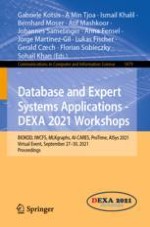This volume constitutes the refereed proceedings of the workshops held at the 32nd International Conference on Database and Expert Systems Applications, DEXA 2021, held in a virtual format in September 2021: The 12th International Workshop on Biological Knowledge Discovery from Data (BIOKDD 2021), the 5th International Workshop on Cyber-Security and Functional Safety in Cyber-Physical Systems (IWCFS 2021), the 3rd International Workshop on Machine Learning and Knowledge Graphs (MLKgraphs 2021), the 1st International Workshop on Artificial Intelligence for Clean, Affordable and Reliable Energy Supply (AI-CARES 2021), the 1st International Workshop on Time Ordered Data (ProTime2021), and the 1st International Workshop on AI System Engineering: Math, Modelling and Software (AISys2021). Due to the COVID-19 pandemic the conference and workshops were held virtually.
The 23 papers were thoroughly reviewed and selected from 50 submissions, and discuss a range of topics including: knowledge discovery, biological data, cyber security, cyber-physical system, machine learning, knowledge graphs, information retriever, data base, and artificial intelligence.
